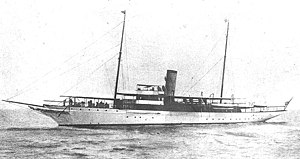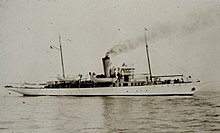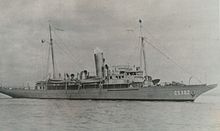
NOAA Ship Rainier is a survey vessel in commission with the National Oceanic and Atmospheric Administration (NOAA). Her primary mission is to chart all aspects of the ocean and sea floor, primarily in Alaska and the Pacific Northwest. The ship is home-ported at the NOAA Marine Operations Center–Pacific in Newport, Oregon.

USS Oceanographer (AGS-3) was a survey ship of the United States Navy during World War II that produced charts chiefly of passages in the Solomon Islands area of the Pacific Ocean. Upon transfer to the Navy, she had initially briefly been named and classed as gunboat USS Natchez (PG-85). Before her World War II Navy service, she had been USC&GS Oceanographer (OSS-26), a survey ship with the United States Coast and Geodetic Survey from 1930.

USC&GS A. D. Bache (1901-1927), often referred to only as Bache, continued the name of the Bache of 1871 and has been confused, including in the Dictionary of American Naval Fighting Ships, with that ship even though an entirely new hull and boiler were built in 1901 and only the name and some machinery and instruments were transferred to the new hull. The Bache of 1901 was transferred to the U.S. Navy for World War I service between 24 September 1917 through 21 June 1919 when she was returned to the Coast and Geodetic Survey.

USS Nokomis (SP-609) was a yacht purchased by the U.S. Navy during World War I. The yacht was purchased from Horace E. Dodge of Detroit, Michigan after he had the yacht luxuriously fitted out but before he could make use of his second Nokomis — the first having already gone into service.
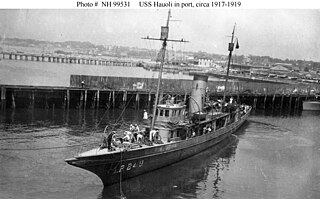
USS California (SP-249) was a yacht acquired by the United States Navy during World War I and outfitted as an armed section patrol vessel patrolling New York waterways. Later, renamed the original name of Hauoli, it was assigned to Thomas A. Edison conducting underwater listening experiments related to antisubmarine warfare.

USS Druid (SP-321) was a private yacht launched 10 February 1902 as Rheclair that was built for Daniel G. Reid. Reid sold the yacht to Senator Nelson W. Aldrich who renamed the yacht Nirvana only just over a year before his death. Aldrich's estate chartered Nirvana to John Wanamaker until it was bought by his son Rodman Wanamaker who used the yacht for cruising until a fire on 14 December 1916, just before a cruise south, severely damaged the vessel. He chartered an alternate vessel for his trip south and, after full repairs, the yacht was sold to Walter W. Dwyer who gave it the name Druid with intentions to sell the yacht to the government in order to finance a shipyard venture in Pensacola, Florida.

USC&GS Pioneer was a survey ship that served in the United States Coast and Geodetic Survey from 1922 to 1941. She was the first ship of the Coast and Geodetic Survey to bear the name.

USC&GS Natoma was built as the private motorboat Natoma in 1913 for Charles H. Foster, President of the Cadillac Motor Car Company of Chicago. In 1917 the United States Navy acquired the boat for use in World War I. The vessel was commissioned USS Natoma for Section Patrol duties and designated SP-666. Natoma spent the war years patrolling New York harbor and approaches. On 9 April 1919 the boat was transferred to United States Coast and Geodetic Survey surveying on both coasts until 1935.

USC&GS Ranger was a steamer that served in the United States Coast and Geodetic Survey from 1919 to 1930 or 1931.

USC&GS Isis was a survey ship that served in the United States Coast and Geodetic Survey from 1915 to 1917 and from 1919 to 1920.

USC&GS Patton (ASV-80) was a survey ship that served in the United States Coast and Geodetic Survey from 1941 to 1967.

USC&GS Gilbert was a launch that served as a survey ship in the United States Coast and Geodetic Survey from 1930 to 1962.

USS Kajeruna (SP-389) was a patrol vessel that served in the United States Navy from 1917 to 1919. The vessel had been built in 1902 as Hauoli for mining magnate Francis Marion "Borax" Smith but was replaced in 1903 by a second, larger vessel he named Hauoli. The first yacht was then named Seminole and for a time was returned to the builder, John N. Robins, and advertised for sale by the designer's firm. In 1911 Clinton W. Kinsella of New York purchased the yacht, apparently already renamed Kajeruna. After naval service the yacht was returned to the owner. On 31 March 1920 the ship was sold to British interests and renamed Tomas W. Beattie.
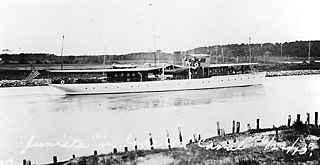
The second USS Juniata (SP-602) was a United States Navy patrol vessel in commission from 1 June 1917 to 13 July 1918. Juniata was built as the private gasoline-powered motor yacht Josephine for Edward Shearson of New York by Robert Jacobs at City Island in the Bronx, New York, in 1911. She was sold in 1914 to George W. Elkins of Philadelphia and renamed Juniata.

USS Onward (SP-311), a former yacht named Galatea and then Ungava was a patrol yacht acquired by the U.S. Navy during World War I. She was transferred to the United States Coast and Geodetic Survey where she served briefly until return to the Navy for a brief time before her disposal by sale. She was renamed Thelma Phoebe.
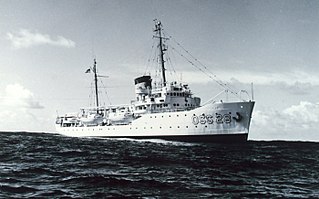
The second USC&GS Explorer was a survey ship that served in the United States Coast and Geodetic Survey from 1940 to 1968. She operated in the Pacific Ocean from 1940 to 1960, seeing service there during World War II, and in the Atlantic Ocean from 1960 to 1968.

USS Siren (PY-13), briefly CMc-1, was built by Pusey and Jones, Wilmington, Delaware and launched 15 November 1929 as the yacht Lotosland. The yacht was acquired by the United States Navy in October 1940 and placed in commission as a Patrol Yacht from 1940 to 1946.

USS Jade (PY-17), was a yacht in commission in the United States Navy as a Patrol Yacht from 1940 to 1945. The vessel was constructed as the yacht Athero II for Jesse Lauriston Livermore in 1926, then sold to Eldridge R. Johnson to be renamed Caroline until replaced by a much larger vessel, also named Caroline, in 1931. The smaller yacht was sold to Joseph M. Schenck of Los Angeles and New York, briefly, before being sold John R. Brinkley, M.D. of Del Rio, Texas, and renamed Doctor Brinkley. In 1940, the US Navy purchased her and renamed her Jade, after the ornamental mineral jade; she is the only Navy ship to bear this name.
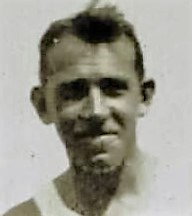
Rear Admiral Robert Francis Anthony Studds was a career officer in the United States Coast and Geodetic Survey Corps, predecessor of the National Oceanic and Atmospheric Administration Commissioned Officer Corps. He served as the fourth Director of the United States Coast and Geodetic Survey.

USS Helianthus (SP-585) was a patrol vessel in commission in the United States Navy from 1917 to 1919, seeing service in World War I. After her U.S. Navy service, she was in commission in the United States Coast and Geodetic Survey as the survey launch USC&GS Helianthus from 1919 to 1939. She was named after the Helianthus, the genus to which the sunflower belongs.
